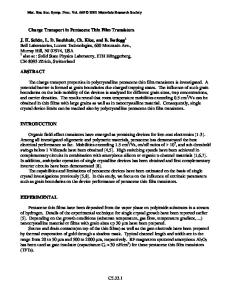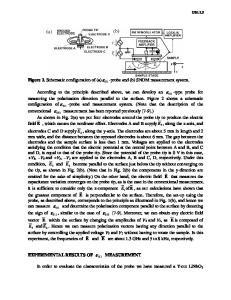Recursive Image Charge Approach for Quantitative Characterization of Dielectric Thin Film Library Using Scanning Tip Mic
- PDF / 88,478 Bytes
- 5 Pages / 612 x 792 pts (letter) Page_size
- 97 Downloads / 306 Views
JJ9.8.1
Recursive Image Charge Approach for Quantitative Characterization of Dielectric Thin Film Library Using Scanning Tip Microwave Near-field Microscopy
Chen Gao, Bo Hu, Mengming Huang, Pu Zhang, Wen-han Liu National Synchrotron Radiation Laboratory and Department of Physics, University of Science and Technology of China, Hefei, 230026, P. R. China ABSTRACT We developed a recursive image charge approach for quantitative characterizations of dielectric thin films using the scanning tip microwave near-field microscope. With this method, frequency shift of the microscope as functions of the dielectric constant and the thickness of a film can be effectively computed in a recursive way. We believe that this approach can promote the high-throughput characterization of the dielectric libraries. INTRODUCTION Ferroelectric/dielectric thin film libraries have been fabricated to screen out novel materials for microwave devices and information applications. To realize high-throughput characterizations of the dielectric properties of these libraries, scanning tip microwave near-field microscope (STMNM) has been used1-6. In order to correlate the microscopy signals with the physical properties quantitatively, iterative image charge (IIC) approach was proposed by Gao and successfully used in the bulk materials7,8. Using the electrostatic approximation and a perfect conducting spherical tip, the field distribution around the tip can be expressed with three series of iterative image charges. Consequently, the frequency and the quality shifts of the resonator (or the effective capacitance of the tip-sample system, equivalently) are quantitatively related to the complex dielectric properties of the materials in an analytic form. So far, this method has enabled quantitative characterizations of the dielectric properties of bulk materials. As the native format of many important applications of the ferroelectric/dielectric materials is thin film, and so do the ferroelectric/dielectric libraries, quantitative characterizations of the dielectric properties of these thin films are extremely desired. To meet the requirement, finite element analysis (FEA) has been introduced to calculate the field distribution9-11. However, the complicated computations of FEA have precluded its routine applications. In this report, we first analyzed the image charge process in the thin film system, then calculated the effective capacitance of the tip-sample system, and finally compared the results of this new analysis with that of FEA. THEORY As described in Ref.7, three series of iterative image charges are used for bulk samples to satisfy two boundary conditions: the equal potential surface of the tip sphere and the continuities on the sample surface. But in the thin film system, the existence of the third boundary, namely the
JJ9.8.2
film/substrate interface, changes the charge image process from iterative to recursive. As shown in Fig.1(a), to satisfy the boundary condition at the film surface, a charge q on the tip sphere causes an image charge
Data Loading...











